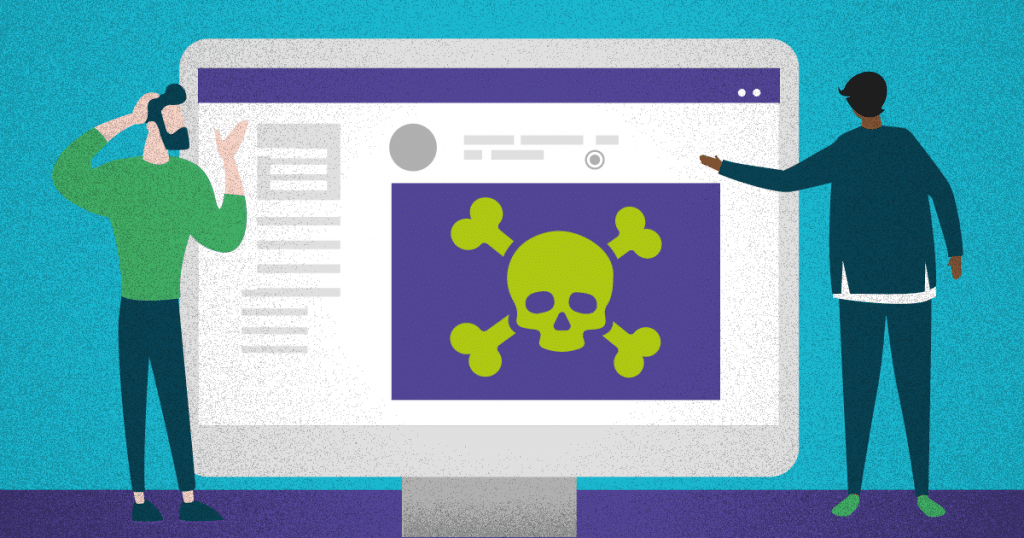Browsing the web is increasingly common to everyone’s routine, but there are still risks when using the internet.
Unfortunately, not every user is online to work, have fun, or deal with everyday issues.
Cyber attacks still common and hackers are always looking to change their ways of getting confidential information. The many types of malware are one of these methods.
There are different types of attacks in this category and each one of them infects computers and web services accounts in different ways.
Malware represents great risks to website functioning and, consequently, to users’ information in online services. It is essential to know the main threats to learn then how to fight them.
This post will detail the subject, showing which are the main malware currently used. They are:
- worm;
- Trojan Horse;
- spyware;
- adware;
- ransomware;
- backdoor;
- scareware.
Know each one of them, the risks they represent and how they can be avoided!

Worm
A worm is a very common type of malware that affects many computers. It can replicate easily, as it does this without depending on any interaction from the infected user.
Once installed, a worm can infect several other computers. While it is active in one place, it can replicate itself to other people.
Criminals use worms to cause damage to computers, preventing them from working properly. These failures create space for data to be stolen and generate varying damage to a computer network. Therefore, worms can be highly damaging to a company, for example.
Generally, the worm’s use is to sabotage company networks and even spy on strategic information.
This malware increases the workload on a network until it overloads, besides deleting files on the host and blocking access to important company information.
Trojan Horse
Trojan horse is one of the most famous malware types. Its name is an analogy to the tale from Greek mythology that describes the delivery of a gift that was actually meant to infiltrate and attack.
This malware does something similar by pretending to be a common program to bring a malicious file to computers.
These files reach users through fake e-mail attachments, software, and several other possibilities. The main point about a trojan horse is the fact that sometimes it seems to be a normal file. This is what makes users download and install it on their computers.
Once present on a computer, the trojan horse opens a back door for hackers to access information, computer files, and users’ confidential data. Through this malware, financial crimes, such as theft of bank credentials, are constantly committed.
Spyware
Website security experts know how dangerous spyware can be for websites. This malware acts as a real spy, collecting information and transmitting it to the people who developed and monitor the malicious software.
As a result, many criminals can leak data from major websites or use information theft to blackmail companies and people.
Spyware can also be used to attack common web users, as it enables the theft of bank data and credit card information, for example. As much as it is not malware that causes damage to a computer, it is dangerous because it allows spying.
Spyware can install itself on computers through security vulnerabilities related to the operating system or even built-in to a Trojan Horse.
Adware
Adware is one of the less aggressive types of malware, but it can still be very damaging to a site precisely because it affects the user experience.
The aim is not to collect data from blackmailing or stealing money but to redirect users to undesired advertising. When installed, Adware removes barriers that a browser imposes to this type of ad.
People create and place this malware on the web for only one reason: they are highly profitable!
Developers earn money every time these ads appear to a user, even if people never agreed to view those banners and pop-ups. Using hosting security tools or WordPress security plugins can help to deal with the problem.
It is also important to note that adware is caused by browser security fails. So keep it updated whenever possible, as developers are always focused on eliminating possible risks.
Ransomware
These are the types of malware that require a ransom to return data to its owner. In its operation, ransomware denies access to a system or even files and data from a computer.
The situation causes despair in the user, who usually needs to use his computer to work, and then decides to pay ransom to get everything back.
Ransomware usually infects a user through phishing emails or by accessing non-secure websites that take advantage of browser security flaws, for example.
Generally, this attack is directed to major companies or people with a good financial situation since there is a ransom charge.
In some cases, ransomware is used only as a theft and data exposure tool, a criminal way to damage sites and companies’ reputations.
Scareware
The scareware depends first of all on the same mechanism used in the adware. Actually, it is a variation of this type of threat, but as the main focus of generating fear in the user.
This is done through advertising that carries false messages indicating that viruses have infected the user’s computer.
However, the final action is different. Instead of just showing an ad, scareware can lead to malicious pages. In these sites, several types of malware can infect the user.
So if you detect this type of ad on a site, know that it is certainly malware besides being not so safe. The infection risk can be high if the user’s browser is not properly updated.
The different types of malware represent risks for every web user. Therefore, knowing its effects, besides using software able to maintain real-time threat detection, is essential.
This guarantees the protection of confidential information for users and websites.
Besides security issues, would you like to know what else can be done to keep your website ahead of the competition? Access Analyzer and check optimization opportunities for your pages!
[rock_performance lang=”en”]







